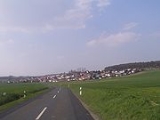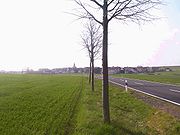
Antrifttal
Encyclopedia
Location
Antrifttal lies, as its name suggests, in the valley (Tal) of a brook called the Antrift, a tributary to the SchwalmSchwalm
The Schwalm is a river in Hesse, Germany, right tributary of the Eder. It rises on the north side of the Vogelsberg Mountains. It flows north through Alsfeld, Schwalmstadt and Borken...
, between the Vogelsberg
Vogelsberg Mountains
The Vogelsberg Mountains are a group duct of ancient volcanic activity and are separated from the Rhön Mountains by the Fulda River and its valley....
in the south and the Knüllgebirge in the northeast (low mountain ranges).
The municipal area of 26.59 km² is 54% agricultural (14.3 km²).
Neighbouring communities
Antrifttal borders in the north on the community of WillingshausenWillingshausen
-Neighbouring communities:Willingshausen borders in the north on the town of Schwalmstadt, in the northeast on the community of Frielendorf, in the east on the town of Neukirchen and the community of Schrecksbach , in the south on the town of Alsfeld and the community of Antrifttal , and in the...
(Schwalm-Eder-Kreis
Schwalm-Eder-Kreis
Schwalm-Eder is a Kreis in the north of Hesse, Germany. Neighboring districts are Kassel, Werra-Meißner, Hersfeld-Rotenburg, Vogelsbergkreis, Marburg-Biedenkopf, Waldeck-Frankenberg.-History:...
), in the east and south on the town of Alsfeld
Alsfeld
Alsfeld is a town in the center of Hesse, somewhere in Germany. Large towns nearby are Bad Hersfeld about 33 km to the east, Fulda 36 km to the southeast, Gießen 47 km to the west and Marburg an der Lahn about 36 km to the northwest...
, in the west on the town of Kirtorf
Kirtorf
Kirtorf is a town in the northern Vogelsbergkreis in Hesse, Germany. Through the town runs the Deutsche Märchenstraße, or German Fairytale Road, a touristic route joining many of the places commonly associated with the Brothers Grimm's tales.-Geography:...
, and in the northwest on the town of Neustadt
Neustadt (Hesse)
Neustadt is a town in the Marburg-Biedenkopf district in Hessen, Germany.-Location:Neustadt lies in the Middle Hessian Bergland at the eastern end of Marburg-Biedenkopf district.-Neighbouring communities:...
(Marburg-Biedenkopf
Marburg-Biedenkopf
Marburg-Biedenkopf is a Kreis in the west of Hesse, Germany. Neighboring districts are Waldeck-Frankenberg, Schwalm-Eder, Vogelsbergkreis, Gießen, Lahn-Dill, Siegen-Wittgenstein.- History :...
).
Constituent communities
- Main town: Ruhlkirchen
- Constituent communities:
- Bernsburg
- Ohmes
- Ruhlkirchen
- Seibelsdorf
- Vockenrod
Ohmes

Ancient Rome
Ancient Rome was a thriving civilization that grew on the Italian Peninsula as early as the 8th century BC. Located along the Mediterranean Sea and centered on the city of Rome, it expanded to one of the largest empires in the ancient world....
, making it one of the oldest places in the Vogelsbergkreis, and the oldest in the Katzenberg, a mediaeval court district in this area. Ohmes had its first documentary mention in 1240 under the name Omeza. It got its name from a body of water called the Omena that welled up just below the village.
In 1240, a third of the village came into the ownership of the Hersfeld Monastery. There was a noble family, the Lords of Ohmes, but they died out in the 13th century. The other two thirds of the village belonged to the court district of Katzenberg under the Counts of Ziegenhain, with its seat at Ruhlkirchen. The one constant in Ohmes's history during the Middle Ages
Middle Ages
The Middle Ages is a periodization of European history from the 5th century to the 15th century. The Middle Ages follows the fall of the Western Roman Empire in 476 and precedes the Early Modern Era. It is the middle period of a three-period division of Western history: Classic, Medieval and Modern...
was change, and the village saw a whole series of rulers, from various lords who held the Katzenberg, to the Teutonic Knights
Teutonic Knights
The Order of Brothers of the German House of Saint Mary in Jerusalem , commonly the Teutonic Order , is a German medieval military order, in modern times a purely religious Catholic order...
, to Hans von Dornberg the Landgrave of Hesse, and above all the Archbishopric of Mainz
Archbishopric of Mainz
The Archbishopric of Mainz or Electorate of Mainz was an influential ecclesiastic and secular prince-bishopric in the Holy Roman Empire between 780–82 and 1802. In the Roman Catholic Church hierarchy, the Archbishop of Mainz was the primas Germaniae, the substitute of the Pope north of the Alps...
.
The German Peasants' War
German Peasants' War
The German Peasants' War or Great Peasants' Revolt was a widespread popular revolt in the German-speaking areas of Central Europe, 1524–1526. At its height in the spring and summer of 1525, the conflict involved an estimated 300,000 peasants: contemporary estimates put the dead at 100,000...
and the Thirty Years' War
Thirty Years' War
The Thirty Years' War was fought primarily in what is now Germany, and at various points involved most countries in Europe. It was one of the most destructive conflicts in European history....
took their toll on the village with their robbery
Robbery
Robbery is the crime of taking or attempting to take something of value by force or threat of force or by putting the victim in fear. At common law, robbery is defined as taking the property of another, with the intent to permanently deprive the person of that property, by means of force or fear....
, plundering, rape
Rape
Rape is a type of sexual assault usually involving sexual intercourse, which is initiated by one or more persons against another person without that person's consent. The act may be carried out by physical force, coercion, abuse of authority or with a person who is incapable of valid consent. The...
, mistreatment and widespread destruction, and while the village had 40 households in 1580, by 1630 it had only 33.
In the early 19th century, the village passed from the Archbishopric of Mainz to the Bishopric of Fulda
Fulda
Fulda is a city in Hesse, Germany; it is located on the river Fulda and is the administrative seat of the Fulda district .- Early Middle Ages :...
, remaining with it until 1889. On 1 January 1971, the until then independent municipality of Ohmes was amalgamated with Antrifttal
At about the turn of the 20th century, the Reverend Williges Kraiger had a church with a vestry built by J. Bensheimer from Dieburg
Dieburg
Dieburg is a town in southern Hessen, Germany. It was formerly the seat of the district of Dieburg, but is now part of the district of Darmstadt-Dieburg.-History:...
. It was consecrated "Zur Heiligen Familie von Nazareth" ("To the Holy Family of Nazareth"), with Williges as its secondary patron. It cost 35,277 marks.
Vockenrod
Vockenrod was presumably founded along with the hereditary estate of Erbleihehof Hermannshain in the 12th century, and was first named in a document in 1263. In 1283, it was part of the court district of Katzenberg under the Counts of Ziegenhain. In the late 14th century, Vockenrod and Hermannshain were both destroyed in a dispute between the County of Hessen and the Archbishopric of Mainz, and it was a hundred years before anyone settled there again.Vockenrod had the same procession of mediaeval rulers as Ohmes (see above). The same wars also wrought heavy destruction on Vockenrod, reducing the village from 20 households in 1580 to only 12 in 1630. Vockenrod likewise also passed to the Bishopric of Fulda in the early 19th century, remaining with it until 1889, and was amalgamated with Antrifttal on the same day as Ohmes.

Saint Boniface
Saint Boniface , the Apostle of the Germans, born Winfrid, Wynfrith, or Wynfryth in the kingdom of Wessex, probably at Crediton , was a missionary who propagated Christianity in the Frankish Empire during the 8th century. He is the patron saint of Germany and the first archbishop of Mainz...
as its secondary patron. It cost 40,568 marks. Within are to be seen elements of Art Nouveau
Art Nouveau
Art Nouveau is an international philosophy and style of art, architecture and applied art—especially the decorative arts—that were most popular during 1890–1910. The name "Art Nouveau" is French for "new art"...
as well as a noteworthy altar
Altar
An altar is any structure upon which offerings such as sacrifices are made for religious purposes. Altars are usually found at shrines, and they can be located in temples, churches and other places of worship...
bearing, among other things, scenes from Saint Boniface's life.

